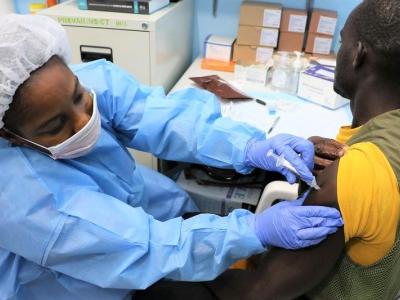Our weekly wrap-up of antimicrobial stewardship & antimicrobial resistance scans
Study finds antibiotic misuse occurs among all education levels
A review and meta-analysis of studies from more than 40 countries found that individuals misuse antibiotics regardless of their education level, researchers reported yesterday in Antimicrobial Resistance & Infection Control.
The researchers conducted a meta-analysis of 85 studies that measured the association between education and any aspect of antibiotic misuse, including use of antibiotics that were not prescribed, non-adherence to treatment guidelines, and storage of leftover antibiotics for future use. The studies encompassed a total of 85,789 subjects from 42 countries of different socioeconomic status, of whom 24,579 had misused antibiotics. Summary odds ratios (ORs) were estimated using a random effects model.
In high-income countries, medium education (9 to 12 years) was associated with 20% lower odds of antibiotic misuse (OR, 0.80; 95% confidence interval [CI], 0.66 to 0.97) compared with low education (9 or fewer years), while high education (more than 12 years) was associated with 14% lower odds of any aspect of antibiotic misuse (OR, 0.86; 95% CI, 0.72 to 1.03). The association between higher education and reduced odds of antibiotic misuse was more pronounced in the Middle East (OR, 0.64; 95% CI, 0.42 to 1.00) and countries of lower-middle economies (OR, 0.67, 95% CI 0.41 to 1.11). Each additional year of education was associated with 4% lower odds of any aspect of antibiotic misuse in lower-middle economies (OR, 0.96; 95% CI 0.92 to 1.00) and in the Middle East (OR, 0.96; 95% CI, 0.93 to 1.00).
In Europe, however, high education was associated with 25% higher odds of antibiotic misuse (OR, 1.25; 95% CI, 1.00 to 1.58). In addition, compared with lower education, high education levels in all countries were associated with 41% higher odds of storage of leftover antibiotics (OR, 1.41; 95% CI, 1.22 to 1.64). Each additional year of education was associated with 3% higher odds of antibiotic storage (OR, 1.03; 95% CI, 1.01 to 1.06).
"This meta-analysis shed the light on the importance of orienting intervention programs to improve the rationale use of antibiotics to all communities independent of their educational level," the study authors wrote. "It also pointed out on the considerable need for cohort studies that examined the association between education and antibiotic misuse and control the measures of association for potentially confounding variables."
Feb 3 Antimicrob Resist Infect Control study
Pharmacist-led intervention tied to fewer antibiotics for E coli bacteremia
Originally published by CIDRAP News Feb 2
A 3-year prospective audit and feedback (PAF) intervention led by pharmacists at a Japanese hospital was linked to reduced antibiotic duration and more appropriate antibiotic use in patients with Escherichia coli bacteremia, Japanese researchers reported yesterday in the American Journal of Infection Control.
The before-and-after study was conducted at a public hospital in Japan where a PAF led by an infection control pharmacy specialist (ICPS) was implemented in 2017 for all injectable antibiotics. The impact of the PAF on the effectiveness of treatment of patients with E coli bacteremia was compared annually over a 4-year period (periods 0 through 3, 2016 through 2019). Thirty-day mortality and duration of antibiotic use were the primary outcomes, and duration of anti-pseudomonal antibiotic was a secondary outcome. Researchers also looked at the economic impact of the intervention.
During the study period, 821 patients with E coli bacteremia were treated, and 537 were included in the final analysis. The pharmacists had 12 and 54 suggestions for antibiotic use in patients in periods 0 and 3, respectively. The most common suggestion was de-escalation of antibiotic therapy.
In periods 0 through 2, the median duration of antimicrobial use was 12 days, then fell to 9 days in period 3. In period 3, the duration of antimicrobial use was reduced by 29% compared with period 0, while the duration of anti-pseudomonal drug use dropped 42%. The 30-day mortality rates were not significantly different between the periods. The total costs of antibiotic use per patient fell 24%.
"This study suggests that a 3-year intervention by ICPS for all injectable antimicrobials may lead to a shorter duration of antimicrobial use, more appropriate use of antimicrobials, and lower healthcare costs by recommending appropriate antimicrobial doses for patients with E. coli bacteremia and promoting de-escalation," the study authors wrote.
Feb 1 Am J Infect Control abstract
Provider-specific feedback tied to improved UTI prescribing
Originally published by CIDRAP News Feb 1
A multifaceted antibiotic stewardship strategy implemented in three emergency departments (EDs) was associated with an increase in guideline-concordant antibiotic choices for patients with urinary tract infections (UTIs), researchers reported today in Clinical Infectious Diseases.
The strategy was implemented at three North Carolina hospitals with the aim of improving UTI prescribing in the ED setting, where UTIs are often inappropriately treated.
Phase 1 of the intervention included an ED-specific, urinary source antibiogram, ED-specific UTI diagnosis and treatment guidelines, an education session for ED prescribers, and department-specific email feedback on UTI diagnoses, antimicrobial use, and guideline-concordant prescribing. An antibiogram is a profile of antimicrobial susceptibility of a microorganism to different antimicrobial drugs. Phase 2 included re-education and provider-specific feedback.
In a quasi-experimental study, researchers used an interrupted time series regression analysis with 2-week intervals to assess guideline-concordant prescribing over the pre-intervention period and the two intervention periods.
Overall, 8,742 distinct patients with 10,426 patient encounters were included in the analysis. Ninety-two percent of all encounters (n=9,583) were diagnosed with cystitis and 8.1% with pyelonephritis (n=843).
There was an initial 15% increase in guideline-concordant antibiotic prescribing following Phase 1, compared to the pre-intervention period (incidence rate ratio [IRR], 1.15; 95% CI, 1.03 to 1.29). Although no significant change in guideline-concordant prescribing was seen initially following Phase 2, a 3% increase in guideline-concordant prescriptions was seen with every 2-week interval during Phase 2 (IRR, 1.03; 95% CI, 1.01 to 1.04), compared with Phase 1.
By the end of the study period, ED prescribers achieved 56.1% guideline concordance, compared with 42.8% in the pre-intervention period and 49.7% in Phase 1.
The study authors say the provider-specific feedback in Phase 2 likely played a role in achieving a sustained increase in guideline concordance.
"While an education session and dissemination of guideline recommendations provided a small immediate effect, ongoing and sustainable effects were only observed when data was consistently fed back and personalized for prescribers," they write.
Feb 1 Clin Infect Dis abstract
Stewardship bundle tied to better antibiotic prescribing for virtual visits
Originally published by CIDRAP News Jan 31
A multifaceted stewardship intervention aimed at virtual visits was tied to improvements in guideline-concordant antibiotic prescribing for upper respiratory tract infections (URTIs) and sinusitis, University of Michigan researchers reported today in Infection Control & Hospital Epidemiology.
The intervention at Michigan Medicine was aimed at improving antibiotic prescribing for URTIs within E-visits, an asynchronous care delivery system in which patients fill out a questionnaire related to symptoms and advanced practice providers (APPs) respond with a written treatment plan.
The intervention included modifications of the existing questionnaire, the addition of a nudge for guideline-concordant prescribing in the electronic medical record, and audit and feedback of APP prescribing. To study the impact of the intervention on appropriate antibiotic prescribing for URTIs, researchers looked at all adult patients who completed E-visits for "cough," "flu," or "sinus" symptoms at Michigan Medicine before and after the intervention was implemented.
From January 2018 through September 2020, there were 5,151 E-visits for the included symptoms. Prior to the intervention, 43.2% of E-visits resulted in antibiotic prescriptions, compared with 28.9% of post-intervention visits. The number of prescriptions with guideline-concordant antibiotic selection rose from 37.9% to 66.1% for amoxicillin-clavulanate and from 13.8% to 22.7% for doxycycline. In addition, median antibiotic duration fell from 10 days to 5 days.
An interrupted time series analysis showed that guideline-concordant antibiotic prescribing increased significantly after the intervention and continued along a similar upward trend over time.
"This approach can aid stewardship efforts in the ambulatory care setting with increases in telemedicine," the study authors write.
Jan 31 Infect Control Hosp Epidemiol abstract
Stewardship strategies to optimize pediatric outpatient antibiotics
Originally published by CIDRAP News Jan 31
In another study published today in the same journal, researchers in Tennessee found that a bundled stewardship intervention was associated with improved appropriate ambulatory antibiotic prescribing for children, despite the COVID-19 pandemic.
The before-and-after study looked at guideline-concordant antibiotic use during three periods at five community general pediatrics practices in Tennessee. Each practice chose two to four implementation strategies known to be effective at reducing outpatient antibiotic use and implemented them in their practice over the entire study period.
Researchers held quarterly meetings with all providers to review de-identified peer comparison feedback across practices. Interventions included antibiotic-use commitment posters, parent education, development of local clinical practice guidelines, and electronic health record template changes.
The three study periods assessed were May 2018 to September 2019 (baseline, P1), Nov 11, 2019, to Mar 20, 2020 (pre–COVID-19 pandemic, P2), and Mar 21, 2020, to Nov 10, 2020 (pandemic, P3).
Improvements in guideline-concordant antibiotic use were observed in the pre–COVID-19 intervention period (P2) and were sustained during the pandemic (P3) for several diagnoses. These included otitis media (P1 72.14% vs P2 81.42% vs P3 86.11%), group A streptococcal pharyngitis (P1 66.13% vs P2 81.56% vs P3 80.44%), pneumonia (P1 70.6% vs P2 76.2% vs P3 100%), sinusitis (P1 76.2% vs P2 83.78% vs P3 82.86%), and skin and soft-tissue infections (P1 97.18% vs P2 100% vs P3 100%).
Practices with higher fidelity to the implementation strategies demonstrated higher guideline-concordant prescribing than those with lower fidelity.
In a survey conducted after the study, more providers reported referring to guidelines to make decisions about prescribing antibiotics following the intervention (38.9%), compared with a pre-intervention survey (5.6%).
"In conclusion, despite the COVID-19 pandemic, this study demonstrates that outpatient antibiotic stewardship implementation strategies are feasible in community general pediatrics practices that are not affiliated with an academic institution, and it provides a framework for real-world implementation of outpatient antibiotic stewardship," the study authors write.
Jan 31 Infect Control Hosp Epidemiol abstract
Study finds drop in resistance gene after fecal microbiota transplantation
Originally published by CIDRAP News Jan 31
A small study of hospital patients colonized with multidrug-resistant organisms (MDROs) found a reduction in the expression of antibiotic resistance genes following fecal microbiota transplant (FMT), South Korean researchers reported late last week in Antimicrobial Resistance & Infection Control.
The single-center prospective study involved patients colonized with vancomycin-resistant Enterococcus (VRE), carbapenemase-producing Enterobacteriaceae (CRE), or both, who underwent FMT from healthy, unrelated donors from May 2018 through April 2019.
x`The primary endpoint was the complete elimination of antibiotic resistance genes 1 month after FMT, and the secondary endpoint included decreased expression of resistance genes. All patient fecal samples were tested via real-time reverse transcription polymerase chain reaction (PCR) on days 1, 7, 14, and 28 for the quantification of VanA, blaKPC, blaOXA, and blaNDM genes.
Of the 29 patients who received FMT, 26 (59.3%) were infected with VRE, 5 (11.1%) with CPE, and 8 (29.6%) with VRE/CPE. The mean duration of MDRO carriage before FMT was 71 days. Sixteen patients (59.3%) received antibiotics before FMT, and 17 patients (63.0%) were treated with antibiotics after FMT. Median patient age was 51 years.
In a culture-dependent method, the expression of VanA and overall genes significantly decreased (P = 0.011 and P = 0.003, respectively) after FMT. In a culture-independent method, VanA, blaNDM, and overall gene expression significantly decreased over time after FMT (P = 0.047, P = 0.048, P = 0.002, respectively). Similar results were confirmed following comparison between each time point in both the culture-dependent and -independent methods.
Regression analysis did not reveal important factors underlying the genetic response after FMT. No adverse events were observed.
The authors say that while the sample size was small and the study did not include a control group, the findings suggest FMT could be an effective way to reduce antibiotic resistance gene expression and facilitate MDRO decolonization.
Jan 29 Antimicrob Resist Infect Control study













